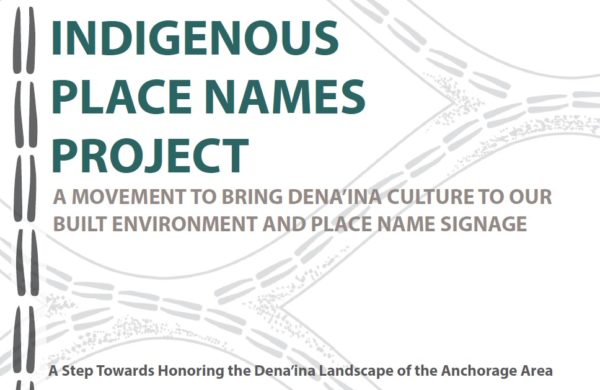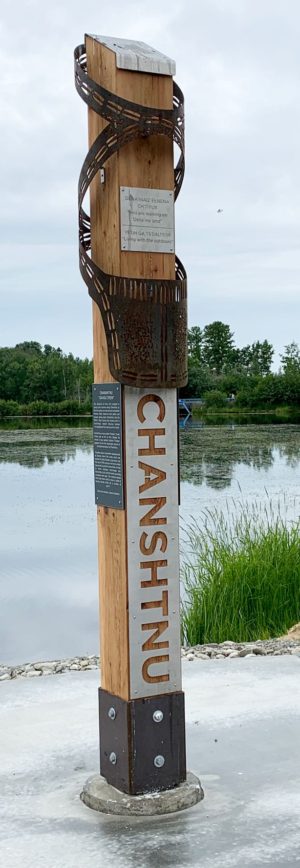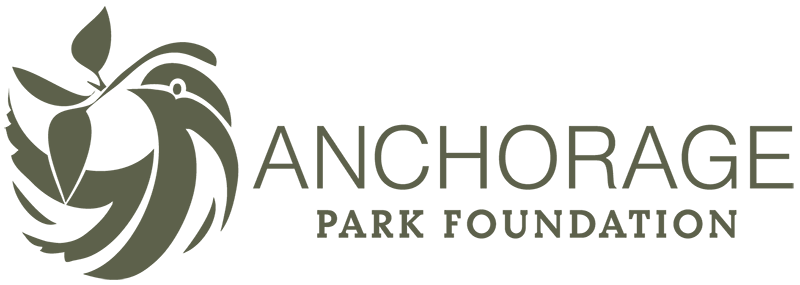
The Beginning of a Movement
For more than a decade, Native Village of Eklutna Chair and CEO/Dena’ina scholar/ Anchorage Museum Curator Aaron Leggett has been working to weave Dena’ina language into the fabric of Anchorage. He reached out to Anchorage Park Foundation to introduce placenames to parks and trails, and in 2018 the Rasmuson Foundation donated a gift to get the project started.
Sculpture, Dena’ina language and explanations of the area’s cultural significance are combined on these public art installations planned for 32 locations in Anchorage and the Native Village of Eklutna. The Dena’ina fire bag was selected as the project’s symbol. Athabascan & Paiute artist Melissa Shaginoff designed the metal sculpture of a fire bag encircling the post. It represents living outdoors and sharing fire and knowledge. The art is also inspired by Dentalium beads. Dentalium is used traditionally and in contemporary clothing, materials, and artwork. It represents fine art.
Each installation features the Dena’ina words DENA’INAQ EŁNENA CH’TIYUX, which means you are walking on Dena’ina land, and YE’UH QA TS’DALTS’IYI, which means living outdoors. These phrases were translated by Joel Isaac, an Athabascan linguist. It is meant to evoke the complexity of place and being on the land as it relates to seasonality, resources, travel, technology, life, and spirit.
The place name sculptures are being installed in phases, with four signs installed so far. There are two locations of Chanshtnu, the Dena’ina place name for Chester Creek, meaning Grassy Creek. Hkaditali describes the place known as Potter Marsh, referring to the driftwood that was accumulated along the tidal flats. It was used for construction, firewood, and fish processing. Nuch’ishtunt means the place protected from the wind, and is now known as Point Woronzof. See pronunciations for all identified locations below.
The Indigenous Place Names Project is a step towards recognizing and honoring the Dena’ina language, knowledge, and innovations in Alaska. Place name art is one physical representation of this shift, but there must also be a shift in processes, recording, mapping, experiencing, and celebrating.
From this project, we’ve learned that to change the paradigm and create a city that honors the Indigenous Place, there must be three components: 1. The leadership of a local culture bearer; 2. Advisory oversight from a broad base of stakeholders; and 3. Involvement of an Indigenous artist if it is appropriate to the project. It is the combination of these three elements that allow a project to become part of a Movement and live beyond initial contributors to the next generation of our community.
Opening Ceremony
More than 150 community members attended the opening ceremony of the Indigenous Place Making project at Westchester Lagoon on August 3, 2021. The celebration was led by Aaron Leggett, President and Chair of the Native Village of Eklutna, and showcased the Dena’ina artistic place making at one of Anchorage’s most beautiful public parks. The ceremony featured performances by Dena’ina artists and speakers included Eklutna President Aaron Leggett, Mayor Bronson, Rasmuson Foundation President Diane Kaplan, and artist Melissa Shaginoff.
Anchorage Daily News: Ceremony Recognizes Dena’ina Place Names Along Anchorage Trails
Alaska Public Media: First Markers in Dena’ina Place Name Project Go Up
Washington Post: ‘We Are Still Here’ Native Americans dispel myths by living their truth
How to Get Involved
The Anchorage Park Foundation is looking for organizations and individuals who want to support both the larger movement and this specific signage project through sponsorship. Sponsoring this movement will help support the implementation of Level 1 and 2 signs as well as other projects within the program. Learn more about this movement and how you can help. Contact Beth@anchorageparkfoundation.org to become part of the movement.
Indigenous Place Names Pronunciations
If you are unsure how to pronounce an Indigenous place name, listen to Native Village of Eklutna Chair and CEO, Dena’ina scholar, and Anchorage Museum Curator Aaron Leggett pronounce each Dena’ina place name and explain its meaning in the Dena’ina language. An interactive map with pronunciations, images for each location will be coming soon.
| Chester Creek (Chanshtnu) | Fish Creek (Ch’atanaltsegh) | Thunderbird Falls (Chishkatnu nudghilent) |
| Ship Creek (Dgheyaytnu) | Potter Marsh (Hkaditali) | Earthquake Park (Nen ghilgedi) |
| Point Woronzof (Nuch’ishtunt) | Campbell Creek (Qin cheghitnu) | Ridge along Upper Campbell Creek near Flattop Mountain (Qin cheghi) |
| Campbell Lake (Qin cheghi kaq ‘bena) | Mount Baldy (Qintali) | Point Campbell (Ulchena bada huch’ilyut) |
| Rabbit Creek (Ggeh betnu) | Lower Peters Creek (K’anakatnu) | Lake Hood and Lake Spenard (Nilkidal’iy) |
| Eagle River (Nuk’elehitnu) | Fire Island (Nutul’iy) | Arctic Valley (Dgheyay tl’u) |
| McHugh Creek (Q’isqa betnu) | Turnagain Arm (Tutl’uh) | Eklutna Lake (Idlu bena) |
| Outlet of Eklutna Lake (Ben q’estiq’) | Eklutna Glacier (Idlu bena li’a) | Creek flowing off of Eklutna Glacier (Bendilent) |
| Eklutna Village (Idlughet) | Eklutna River (Idluytnu) | Larger knob near the Native Village of Eklutna (Idlika’a) |
| Small knob near the Native Village of Eklutna (Idlishla) | Head of Eklutna Lake (Qunsha qeneh) | Small creek feeding Eklutna Lake (Yuditnu) |
| Mount Hunter (Begguya) | Mount Foraker (Be’u) | Chakachatna River Valley (Ch’akajatnu) |
| Denali (Dghelay ka’a) | Mount Susitna (Dghelishla) | Point Mackenzie (Dilhi tunch’del’usht beydegh) |
| Mount Spur (K’idayq’eni) | Knik Arm (Nuti) | Mount Gerdine (Qayeh dghelaya) |
| Mount Torbert (T’etniya) | Cook Inlet (Tikahtnu) |


